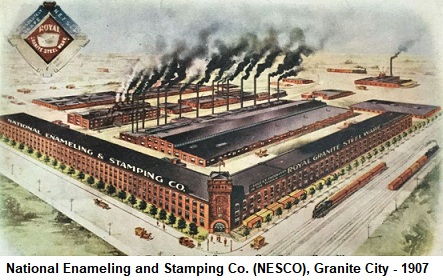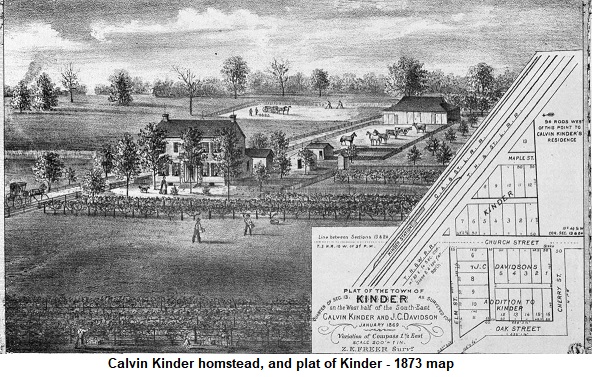Early Granite City History
Granite City Newspaper Articles
Recommended reading: Granite City Pictorial History
Early Settlers
Between 1680 and 1753, the French controlled what was called
Illinois Country. They established a
settlement on Chouteau Island, west of the future site of Granite City, where they bred
horses and shipped them to New Orleans on flat boats. In 1770, what
was known as the first great flood washed the settlement away,
including the French cemetery on the island. Following the French
and Indian War of 1754-1763, Great Britain took control of Illinois
County, and after the American Revolution, Illinois Country was
secured for the United States.
In 1801, the Wiggins family and Patrick Haniberry arrived at the
north edge of Horseshoe Lake. They named the area in the American
Bottoms "Six Mile
Settlement, as it was located six miles from St. Louis. The American
Bottoms was an area with rich soil due to the frequent flooding of
the Mississippi River. In 1802, Dr.
George Caldwell, who poled his way on a skiff from Ohio, bought 200 acres of land in what is now West Granite City,
making him the first known European settler in present-day Granite
City. He farmed and practiced medicine. Other settlers at that time
included Nathan Carpenter, who built the first horse mill; William
Gillham, who built cabins on the southern bank of Long Lake and began
farming; and the Cummings, Waddles, Hayes, Loftus, Clark, Stallings,
Kinder, Squire, Andrew Emmert, Henry Hayes, and the Griffins, who
settled near Long Lake.
George Kinder was born in Pennsylvania on February 12, 1783. Soon
after the American Revolution, his family moved to Kentucky, where
his father, Jacob Kinder, was killed by Native Americans. George
moved from Kentucky to Illinois in the Fall of 1811, and settled on
the northeast quarter of section thirty-six in Six Mile Prairie,
Madison County. His wife was Isabella Roseberry Kinder. After some
years, he brought his mother and sister, Nancy Kinder Wilcox (wife
of Stephen Wilcox) to Six Mile Prairie. George was a Private in
Captain Samuel Judy’s Company of Mounted Illinois Militia during the
War of 1812. He died on his farm on May 31, 1856, and is buried
in the Oak Lawn Cemetery in Glen Carbon. George and his wife had
nine children: Jacob Jefferson Kinder (1809-1885); Mary A. Kinder
Jarvis (1813-1902), wife of Wesley Jarvis; William Kinder
(1816-1872); Eleanor Kinder Montgomery (1819-1900), wife of Nelson
Montgomery; Nathaniel Buckmaster Kinder (1821-1900); James Roseberry
Kinder (1824-1860); George William Kinder (1831-1917); Jane R.
Kinder, who married Robert Holliday; and Robert H. Kinder.
In 1812, a blockhouse was constructed in the present-day Worthen
School area, to protect women and children during the Indian wars.
In 1814, Isaac Gillham’s oldest daughter, Margaret, married John
Davison, and they built their home on land now occupied by the YMCA,
library, and Niedringhaus United Methodist Church.
Calvin Kinder, possibly George Kinder's brother, was born in
Pennsylvania in 1804, and came to Illinois in 1820. He settled in
the Six Mile Prairie, and took a leading position in the church and
community. He was an earnest, devoted, conscientious man. The Six
Mile Settlement changed their name to Kinderhook, in honor of Calvin
Kinder. Later, the railroad built a station in the area, and it was
named Kinder.
In 1822, William Emmert arrived in Six Mile Prairie with his widowed
mother, Christina, and four teenage sisters. He erected a home in
1837, where he would later own three famous racehorses, as well as
large apple, peach, and pear orchards.
In 1838 a post office was established in the precinct of Six Mile,
with J. Squire as Postmaster.
In 1840-1849, floods and malaria plague the area. The flood waters
reached the highest level in history, covering all of the American
Bottoms and causing massive destruction. Many settlers sold their
lands, while others began constructing levees and canals to control
the water. In 1849, a cholera epidemic, thought to have been brought
by German immigrants, killed 80% of the population.
The Niedringhaus Brothers
Kinderhook remained a model farming community until 1891, when the
Niedringhaus brothers arrived.
William F. and Frederick G. Niedringhaus immigrated to St. Louis
around 1858, after having trained under their father, Frederick Sr.,
a tinner and glazier. The brothers founded the St. Louis Stamping
Company in 1866, which had immediate success. Their tinware met the
public demand for durable, affordable kitchenware. The brothers
developed and patented their famous granite ironware. Seeing
limitations to enameled kitchenware, they sought to improve its
performance. They came up with a process in which a sheet-iron body
was coated in highly vitrified glass. The coating was insoluble,
blocking cooking oils and food acid that caused oxidation in iron.
The process for production was developed by April 1874, when the
first piece was made. The Niedringhaus’ St. Louis Stamping
Granite City Incorporated
Granite City was incorporated in 1896 with a mayor–council form of
government. No Niedringhaus family members ever served in the city
government, although they had a hand in the finances of everything
from banks to gas companies. The city hired Henry Fossiek as its
first policeman. The first brick building erected in Granite City
was located at the corner of 19th and State Streets. The building
was home to the Julius Rosenberg store, who was a former mayor of
the city.
Early Schools in Granite City
In 1857, the first school was built in Kinder, and was named
Kinderhook, as the people thought Mr. Kinder had “hooked” the money
for his church from school money. It was a two-story building,
housing the school on the first floor, and a church on the second.
The first Granite City school was built in 1896, and named for Ralph
Waldo Emerson. Within ten years, population needs and steady
increases in revenue led to three additional schools being
constructed. In 1899, Washington School was opened. In 1901, two new
schools are opened, one near the levee for African-Americans, and
the other for white students on the west side of the tracks.
Early Churches in Granite City
In 1830, a church was built in Six Mile Prairie near the house of
Thomas Gillham. The early members include Thomas Gillham, William
Gillham, John Gillham, Thomas Y. Lofton, Moses Seeds, Joshua
Delaplain, William Snyder, O. W. Sims, Calvin Kinder, Peter Barco,
and Ephraim Davidson. Under the auspices of Calvin Kinder, a new
brick, two-story building was erected in 1856 for a church and
district schoolhouse. The upper story was used for a church, where
the society worshipped until 1880.
In 1836, the Methodist Episcopal Ebenezer Church was erected on
Chouteau Slough. It was an unadorned log house, and the church yard
contained a cemetery. In 1840, the Methodist Episcopal Six Mile
Church was erected near the Edwardsville plank road, six miles east
of the Mississippi. The most prominent members of the two churches
included Benjamin Irish, T. J. Irish, Samuel Squire, Peter Barco,
Calvin Kinder, George A. Kinder, Samuel Kinder, J. W. Delaplain, J.
Davidson, Wesley Lucas, James S. Smith, Thomas G. Lofton, William
Atkins, William Snyder, Captain William Gillham, Isaac Gillham,
Newton Gillham, George Hayes, John Hayes, Charles Harward, John
Woods, and Isaac Bradon.
